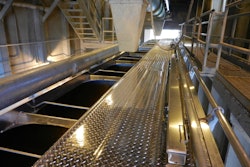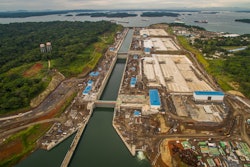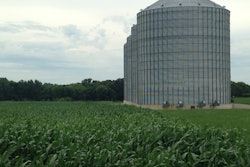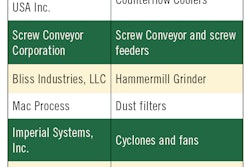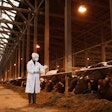
Farmers are growing more grain like never before, some of it through expansion of the acreage they plant, and much of it through yield boosts brought about by improved varieties that tolerate heat, drought, pests and weeds.
From just 2003 to 2015, corn yields rose from 10.1 billion bushels to 13.7 billion bushels/year. So, it’s no surprise that capacity at grain storage facilities has risen to accommodate the need.
Off-farm storage facilities increased capacity to 10.7 billion bushels in 2014, according to the U.S. Department of Agriculture’s National Agricultural Statistics Service (NASS). That’s up more than 25%.
All that capacity, however, has come from far fewer facilities. NASS data also show that there were nearly 9,800 off-farm grain storage facilities in 2003. But that number dropped to about 8,700 by 2014.
Grain storage handlers are consolidating their businesses and expanding their new creations. Larger companies are buying up some of the small operations in order to increase their capacity. Some smaller operations are combining to keep up with competition and demand. Other plants are expanding on their own to keep up with the rising amount of grain coming in on trucks from nearby farms.
“Around the industry, there are a lot of co-ops — small operations with little capital available to execute projects to meet growing demands,” says Steve Minnich, business development manager at ADF Engineering in Miamisburg, OH.
Many of those existing operations are also dealing with the consequences of time.
“Generally speaking, the infrastructure across the United States is aging, and because of an increase in yields, the demands placed on that infrastructure are greater,” says Brad Clark, president of Agspring, an agricultural infrastructure holding company based in Leawood, KS.
No matter the reason, many feed storage operations are expanding or planning to do so. Clark and Minnich say the key to a successful expansion requires long-term planning and attention to detail.
Planning ahead
Changes in agriculture, especially with yields, have come quickly. It might sometimes seem like grain handlers have to make equally quick decisions to keep up. But Minnich says it’s best to take a step back and determine if the solutions you’re considering now will be good strategy for three to five years out.
“We see clients spend considerable time and money on what they think are the best options for their facility, but they may be setting themselves up for problems,” explains Minnich, whose company provides process and facility engineering solutions for the food, feed, fuel and bioscience industries. “We encourage clients to be proactive to prevent knee-jerk reactions. It’s critical to success.”
According to Clark, clients should be thinking about the big picture and looking at all the options. Maybe an on-site expansion is the way to go. Or maybe there’s an opportunity to grow larger by adding another location.
“We take a hard look at what the market needs from both a customer and a grower’s standpoint,” Clark states.
There may be opportunities to expand into a growing segment, such as isolation of non-GMO varieties or organic grain, or segregating medicated and nonmedicated feed.
It also means steering away from duplicating services already offered or in the works nearby, which only hurts business for both companies.
“You might be able to find a Starbucks on every corner, but that doesn’t work in the ag world,” Clark says. “You don’t want to build a shuttle loader right across the street from another shuttle loader.”
From a construction standpoint, it’s important to know what’s actually possible at your plant. Minnich finds that oftentimes drawings aren’t kept up to date, but it’s important to know those details to allow for new equipment arrangements.
“Can the process changes and new technology selections be built into your existing facility, or do you need a whole new facility?” Minnich states.
Minnich’s company uses 3-D laser scanning technology to generate models of the plant, giving key information on how an expansion or new equipment will integrate into existing facilities.
The resulting plans are shown to everyone who works on or maintains equipment in the plant to ensure the project is feasible. During those reviews, ADF’s key considerations for their clients are to make sure the end result is a facility that is safe, maintainable, and functional — all while complying with industry regulations.
“3-D modeling allows us to use software to put new equipment in place to see how it will fit. It also allows us to see what type of building modifications or construction will make it work. We have to identify their bottlenecks and constraints,” Minnich says. “We get to be very creative with how we design the layouts.”
Financing
Hand in hand with design and engineering is how bills will be paid.
Clark says he wants to make sure clients look at profit calculations to make sure their expansions make business sense. And he wants to know if there are other options that could help pay for themselves and increase the chances of success.
“Does it make sense to put in a rail spur? Does it make sense to put in some storage on the other side of the county to build some demand? Does it make sense to increase your dump speed?” Clark explains. “These are the things we want to think about.”
Financing is also key. From the start, Minnich encourages clients to build in a reserve for cost variances, which are common in any new construction or expansion project.
Minnich adds that it’s his company’s job to be aware of issues that might not have come up when the plant’s leadership sat down to get a rough idea of costs. It’s often more than simply parts plus labor. If facility upgrades are complex, or project circumstances are undefined, the costs are going to go up.
“Most clients are a little low on the reality of the costs,” Minnich says. “We help them develop more accurate expectations early on, before the project gets too far into the design phase and rework then needs to be done.”
That doesn’t mean that an expansion or upgrade to the operation is off the table. Sometimes it means adjusting to a new plan that still makes financial sense.
“We look at the ways they’re doing business today and what their success criteria look like,” Minnich explains.
With plans in place, funding then comes into play. Some businesses will be able to obtain traditional loans or use equity to finance a project. Others may not have access to those funds, and Clark suggests a company like Agspring, which has extensive equity resources and credit relationships to provide a solid platform for capital improvement and expansion opportunities.
“This helps them get resources they might never have,” Clark says. “There is so much that we help with, such as HR and OSHA requirements, so they can focus on running their operation safely and working with their customers.”
Construction timelines
Setting a successful work schedule that allows for minimal interruption of business takes a lot of communication. Minnich suggests coordinating operations, maintenance and other players whose work could be impacted by construction.
“We try to get a thorough understanding of where there is flexibility in their scheduling,” Minnich says. “If we get all these people in the room, we are much more likely to uncover any issues we have to plan around. We work with plant officials and with construction crews pretty closely to put together a good schedule.”
That determines how long the work will take overall. It’s entirely possible that construction could be finished without interruption. However, if the timing of the project’s start would require essential portions of the plant to be shut down during high-volume work times, it would be wise to know that ahead of time so you can plan accordingly.
Minnich said it’s fairly common to find clients who have unrealistic expectations of when a project should start and when it should be completed.
“Sometimes it’s not realistic. We do our best to make scheduling estimates using the completion date they want, and then work in our design phases backward from there,” Minnich says. More often than not, clients realize that their timeline needs to be adjusted.
The problem is that as well versed as the businesses are in grain storage, they aren’t used to the sorts of issues that delay construction.
“They don’t really understand [the construction] industry as much, since they don’t work in it,” Minnich says.
In the end, the planning may take more time than the construction, but Clark and Minnich say it’s worth it if it means choosing the right technology, financed properly and installed with an eye on keeping operations running smoothly.
“We are here to figure out how we can optimize long-term operational costs,” Minnich says.


